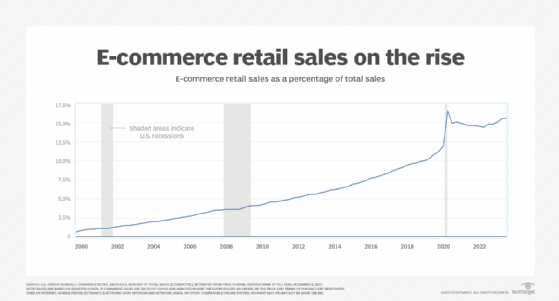
Getty Images/iStockphoto
Top e-commerce challenges for 2023 and how to overcome them
2023 will bring many e-commerce challenges that were exacerbated by the COVID-19 pandemic, like international trade and rising customer expectations. Here's how to overcome them.
Because of the pace at which the internet and technology develop, e-commerce was an inevitable evolution.
The COVID-19 pandemic, however, accelerated e-commerce growth further. Store closures and restrictions on movement resulted in more online purchases than ever before. That growth continued into 2022, and the market will amount to $8.1 trillion by 2026, according to Statista, which is a 56% increase.
This development also led to some of the biggest e-commerce challenges for brands and retailers. Customer behavior continues to change, new competitors enter the market daily and data privacy laws have become more complex to navigate.
For proactive brands and retailers, these challenges are opportunities to strengthen their positions and grow their customer bases. In this post, we'll explore the biggest challenges the e-commerce industry will face in 2023 and how to overcome them.
Challenge 1: Rising customer expectations
Technological advancements mean brands and e-commerce store owners must keep up with an increasingly demanding customer base. Consumers want a simple and convenient shopping experience that's personalized and engaging. They want to be able to track their orders, purchase across multiple channels and receive real-time updates about the status of their orders and deliveries.
To keep up, small e-commerce businesses must anticipate what consumers expect and meet these expectations. The best ways to accomplish this goal are indirect research and direct communication. For example, after-sale surveys, social media monitoring and direct communication with the support team are all ways to collect information about customers' expectations and complaints.
Businesses must understand buyers' biggest pain points and design solutions based on their feedback. Some of these solutions include the following:
- Self-service options. Self-service could include chatbots on websites or mobile applications that answer questions or assist with order-related queries. With 24/7 support, customers can ask questions anytime and get answers quickly.
- Various shipping and pickup options. Customers have different needs when it comes to delivery options. Some people prefer in-store pickup, and others may want free overnight shipping or next-day delivery.
- Different payment options. Not everyone is comfortable using credit cards online. Some people prefer to pay with other online payment services or use cash on delivery.
- Simple checkout processes. When customers check out, they shouldn't have to fill in numerous fields with their personal information every time. Instead, they should have the option to save information to purchase items more quickly in the future.
Challenge 2: Competition from direct-to-consumer brands
Direct-to-consumer (D2C) brands sell products or services directly to customers instead of using resellers or distributors. These brands have been around for a while, but they came to the forefront during the pandemic.
The D2C e-commerce market grew significantly in 2020, according to Smart Insights, reaching $111.54 billion. This rise is not surprising considering the delay in supply chains, order delays and the shutdown of in-person retail that the pandemic caused.
For example, the SaaS industry has seen the biggest growth among D2C companies. Innovative software has become attainable even for customers with modest budgets, thanks to accessible subscription-based pricing models. By cutting out the intermediaries, D2C brands can offer quality at lower prices.
As most D2C brands start with meager marketing budgets, they devise innovative marketing strategies. Tactics like influencer marketing, content marketing and personalization can help attract new customers and maintain customer loyalty in the long run. Some D2C brands create online communities where customers can actively shape the product development roadmap.
To shape this roadmap, brands can take the following steps:
- Create a solid online presence and product catalog.
- Regularly produce high-quality content to engage target audiences through various channels.
- Provide seamless user and shopping experiences.
These steps can help collect valuable insights into customers' needs and provide products and services that address those needs.

Challenge 3: Cross-border trade
Cross-border trade emphasizes the strides e-commerce has made in the last few years and presents retailers with new opportunities to grow their businesses by tapping into previously inaccessible markets.
However, this growth comes at a cost for some online retailers. Some challenges include the following:
- Cross-border delivery. This can be challenging -- particularly if third parties handle shipment. E-commerce businesses that operate internationally should consider having a network of local warehouses instead of a single, central headquarters. While they aren't cheap, warehouse networks can streamline shipments, reduce the risk of lost merchandise and lower costs.
- Language barriers. Most e-commerce platforms only offer support in their native languages, although players like Shopify and BigCommerce are making improvements This can cause delays in resolving issues, such as customer complaints. Merchants who want to benefit from cross-border trade must offer support in multiple languages. Investing in multilingual customer support can dramatically improve customer satisfaction and boost sales.
- Currencies. In some cross-border scenarios, currencies differ between countries, making price calculations more complex and costly for the retailer. Partnering with payment processing providers that can support transactions in multiple currencies can help businesses trading across borders and dealing with foreign currencies.
Challenge 4: Consistency across channels
Improving CX also means ensuring a consistent experience across all channels. The omnichannel experience requires brands to be present on various platforms, as long as these channels are appropriate for the brand's target consumers. Even more importantly, brands must offer a seamless experience across channels.
Consumers should be able to shop with ease across channels without experiencing hiccups or inconsistencies in customer service, product availability, pricing, content, delivery options, etc. This requires brands to understand their target audience, what motivates them and how they make decisions.
To create consistency across all channels, companies should ensure the following points are consistent:
- corporate story;
- messaging;
- products and services;
- look, including logo, typography, layout, etc.; and
- interactions with customers across different touchpoints -- such as phone calls and live chats -- and through different communication tools, such as emails and social media.
Challenge 5: Data security
Data security is among the biggest e-commerce challenges, and it will continue to be in 2023.
Businesses put a lot of effort into developing data-driven e-commerce services. These services can help brands with shipping, retail management and multichannel approaches, such as buy online, pick up in-store and buy online, ship to store.
However, the amount of data that needs to be processed and stored is enormous -- from customer profiles and purchase histories to website analytics and inventory management data. Additionally, all this data must be secured against cyber attacks, data breaches, viruses, hacking attempts and more. Tackling these data security concerns requires an IT infrastructure capable of handling huge amounts of data to ensure its security and privacy.
For example, when it's time to choose a payment processor, businesses should primarily focus on Payment Card Industry Data Security Standard compliance, which is the minimum level of security for processing online transactions.
Companies can also benefit from the expertise and support offered by payment service providers, who offer the following:
- Onsite penetration testing to fraud detection. This testing minimizes the risk of compromised sensitive data and provides peace of mind for merchants and their customers.
- Encryption of sensitive data. As hackers get smarter by the day and security loopholes become more common, companies need strong encryption algorithms to protect their customers' personal data -- especially when it's being transmitted over the internet.
- Tokenization of payment credentials. While encrypted credit card information prevents unauthorized users from accessing it, tokenization renders the information useless if stolen -- effectively reducing the risk of fraudulent charges.
The bottom line
In 2023, the e-commerce industry will continue to grow. Because of its fast-paced nature and constantly changing business environments, we can expect more challenges in 2023. Consumer behavior will continue to change, data security threats will continue to rise and the boundaries between physical and digital shopping will continue to blur.
However, businesses that keep up with these trends will be able to seize opportunities to grow revenue and boost sales.
About the author
Robert Brandl's passion has always been web tools that make life easier. That's why he founded Tooltester, where you can find reviews and tutorials for the world's best website builders, e-commerce platforms and web hosting services.






